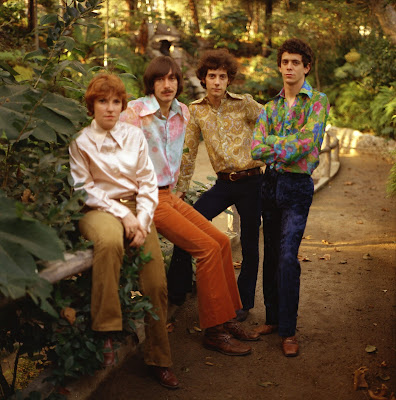The Velvet Underground and the World Around Them
By Moira Jean Sullivan
The Velvet Underground by Todd Haynes was presented out of competition at the Cannes Film Festival in July, a documentary on the experimental music group who did live shows and put out four albums in the 60’s. They were New Yorkers and hated the west coast scene: flower power, the hippies and Phil Graham , according to drummer Moe Tucker actress and Mary Woronov. Founded in 1964 by singer guitarist Lou Reed, Welsh multi-musician John Kale, guitarist Sterling Morrison and drummer Angus MacLise - later replaced by Moe Tucker, you can hear Moe’s beat in the bands famous "Venus in Fur". Andy Warhol was misidentified as the leader of the band but his brief association is confirmed in the documentary, also that he was fired by Lou Reed. German singer Nico was also in the band who is often referred to for her beauty rather than her music. According to John Cale, Nico was indifferent to the superficiality of the scene especially Warhol and spent her time writing lyrics and poetry. She was praised for her small role in Fellini’s La Dolce Vita in 1960 with Marcello Mastroianni and Anita Ekberg - who was the ingenue in that film. There are few women in the history of the The Velvet Underground band but of course they were there and are interviewed such as actress Mary Woronov, Sterling Morrison’s’ wife Martha Morrison, experimental musician Mariane Zazeela, Merril Reid Weiner - Lou's sister, and Moe Tucker. The film is a kaleidoscope of stories of various band members during their brief history edited using the split screen of 60's film production which is ideal for the storytelling of Todd Haynes engrossing doc, and the artistic impulses are brilliantly assembled. It takes some time to process the fusion of sound and image and it will require more than one viewing to do the history justice. Allen Ginsberg is there reciting his famous poem Howl, and the filmmaker's cinematheque of expanded art and cinema. Jonas Mekas opened it on 41st St in Time square. As a young man, he called American poetic film "a conspiracy of homosexuals" in 1955 (Film Culture) but changed his position especially when confronted by Maya Deren about his homophobia. He later publicly acknowledged Jack Smith and Maya Deren.
Lou Reed is presented as a daring musician that wanted to be a rock star and who would push people to their limits. He went to gay bars that were the first places he was booked and was beloved by women and men. At the time homosexuality was considered a crime against nature and punishable by 20 years in the state penitentiary. The experimental art world was exploding and connected to capital, cultural power and cinema such as the New York Film Festival. There was the emergence of camp, a voyeuristic connection to art and people because of its negative attraction and homosexuality was often associated with camp. Gay artists presented include filmmaker Jack Smith who made Flaming Creatures (1963) and gay icons Mario Montez and John Waters and Kenneth Anger (Scorpio Rising 1963). Openly gay director Todd Haynes makes ample references to the political and cultural history. One of the gay clubs was San Remo in NYC Reed went to. The club scene extended to Andy Warhol's "The Factory" where people came to be filmed and hopefully famous, or already were.Film critic Amy Taubin is interviewed who said it was "not a good place for women". Valerie Solanas, author of the infamous and misunderstood SCUM manifesto, is a silent voice during the 60's art scence who comes to mind who shot Andy Warhol for ignoring her in his inner circle and allegedly stealing her work.
Lou Reeds lyrics have been compared to sonnets by Baudelaire and Rimbaud for his openess in discussing taboo subjects such as homosexuality and transsexuality. John Cale said the music of The Velvet Underground expressed "how to be elegant and how to be brutal". The cross-fertilization of Lou Reed's music with David Bowie is later evident in "Take a walk on the wild side" on the Transformer (1972) album by Lou Reed after he left The Velvet Underground, produced by David Bowie.
Part of the experimental music of the time was the "harmonic series", and John Kale explains that one of the tones in life was the 60 cycle hum of a fridge as the drone of western civilization. Another artist mentioned was the innovative Tony Conrad, musician and composer in the Theatre of Eternal Music or Dream Syndicate. Also in the collective was Mariane Zazeela. La Monte Young, a minimalist musician, was another personality working with sustained tones that produced a high spiritual state such as the Alpha rhythm of the brain. This is synchronized with a clip from Andy Warhol’s five and a half hour experimental film Sleep(1964) who used sustained time in film.
Multimedia artist, electronic music composer and filmmaker Laurie Anderson asked Todd Haynes to make the documentary on her late husband Lou Reed. They were together for 21 years and some of the material come froms her collection. The Velvet Underground will be released on Apple TV on October 15.
Movie Magazine International Photos ©Festival de Cannes used with permission



Comments
Post a Comment